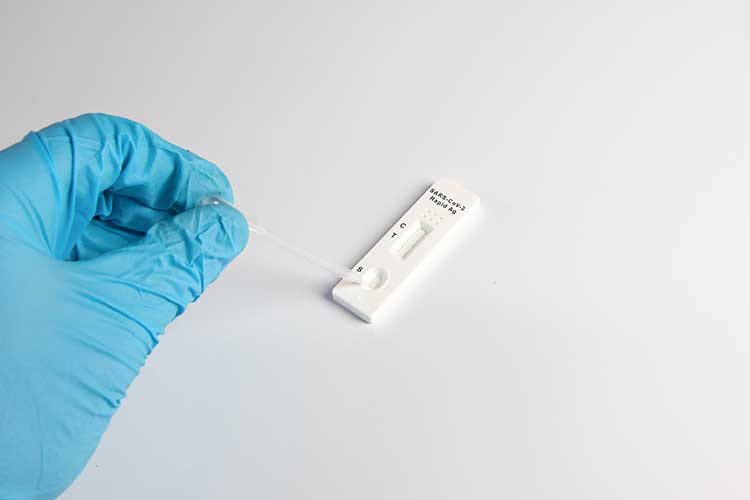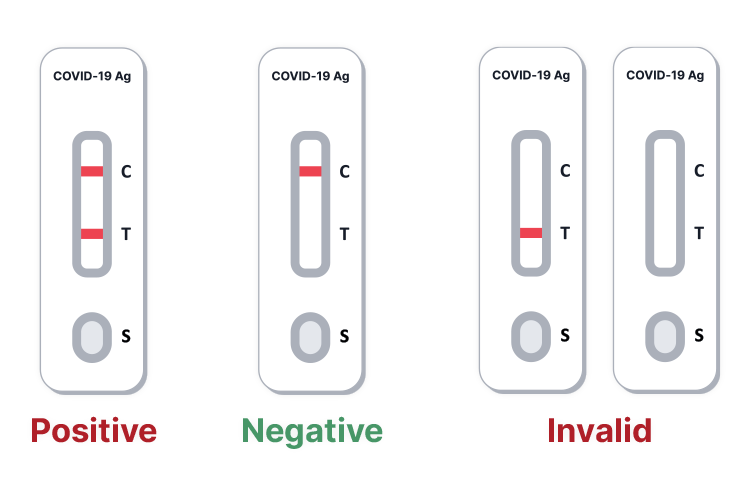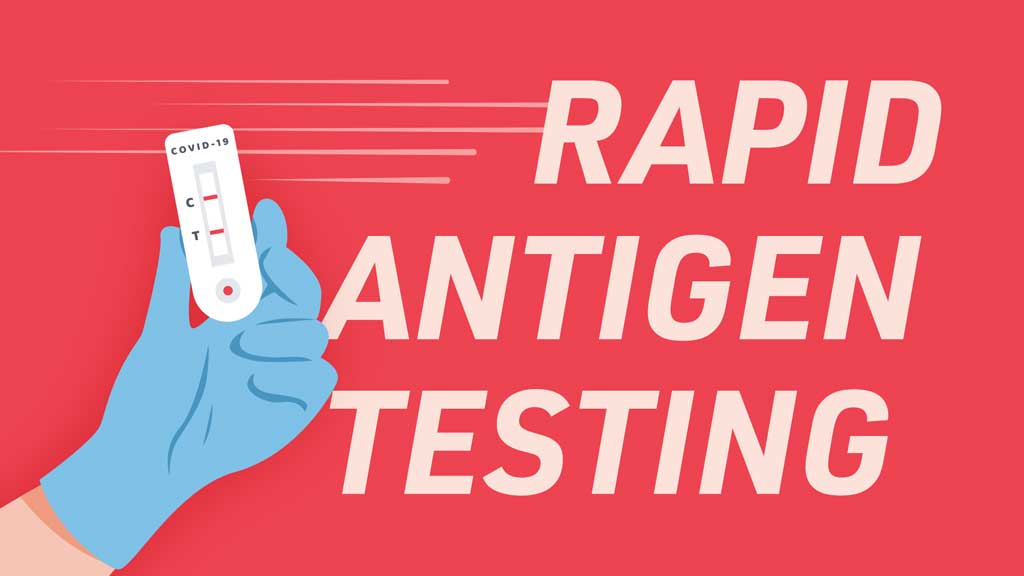Rapid antigen testing (RAT) is a type of test used to detect COVID-19.
RAT involves swabbing the nose or mouth and then placing the swab in a chemical solution (NSW Government 2023). It works by detecting and reacting to proteins (antigens) on the surface of the COVID-19 virus (ABC News 2021).

What is the Difference Between RAT and PCR Testing?
There are two types of COVID-19 tests used in Australia: rapid antigen testing (RAT) and polymerase chain reaction (PCR) testing.
RAT is a screening test, while PCR is a diagnostic test (NSW Government 2023).
Furthermore, there are two types of RAT:
- Rapid antigen self-tests, which can be used at home by the general public
- Rapid antigen point-of-care tests, which must be performed by appropriately trained healthcare professionals or trained people working under supervision.
(Healthdirect 2023)
PCR testing, which works by detecting the presence of SARS-CoV-2 viral ribonucleic acid (RNA), is the gold-standard method of COVID-19 testing in Australia (TGA 2022).
However, unlike PCR testing, which takes several hours to generate results and requires specialised laboratory equipment, RAT is able to provide a result within 15 to 30 minutes (TGA 2022).
RAT is able to detect potential COVID-19 cases in the early stages of infection, sometimes even before the onset of symptoms (NSW Government 2023).
RAT performs best during the early stages of acute infection, within five to seven days of the onset of symptoms.
However, while RAT can detect most cases of COVID-19, it is less sensitive than PCR testing and less reliable for screening asymptomatic people (TGA 2022).
What Does a Rapid Antigen Testing Kit Contain?
A RAT kit should contain:
- A swab inside a sealed wrapper
- An extraction tube holder
- An extraction tube
- An extraction buffer sachet
- A test strip
- A waste bag.
(Department of Health and Social Care 2021)
How to Perform a Rapid Antigen Test
Testing kits may differ. Always follow your local policies and procedures, as well as the instructions of the testing kit, when performing a RAT.
- Read the test kit instructions.
- Clear, clean and dry an appropriate flat surface for the test kit to be placed on.
- Perform hand hygiene.
- Unpack the test kit, checking that all components are present and the kit is in-date.
- Place the test strip on the cleaned surface.
- Twist or snap open the extraction buffer sachet. Take care not to spill any of the fluid inside.
- Open the extraction tube and pour all of the fluid from the extraction buffer sachet into the extraction tube.
- Close the extraction tube cap and place the extraction tube in the extraction tube holder.
- If performing the test on someone else, confirm the patient’s details and gain their consent to perform the test.
- Ensure the person taking the test blows their nose before taking the sample, as excess mucous or blood can interfere with the results.
- Perform hand hygiene.
- Remove the swab from its packet. Do not touch the soft fabric tip of the swab.
- The person taking the test should tilt their head back.
- Swab the nostrils or throat according to the test kit instructions.
- Slowly remove the swab.
- While still holding the swab, pick up the extraction tube and open the lid.
- Place the fabric tip of the swab inside the tube, into the fluid.
- Stir the swab in the extraction tube according to the test kit instructions.
- Lift the swab and squeeze the extraction tube to drain the remaining fluid from the tip of the swab into the extraction tube.
- Break the swab at the breakpoint and discard the top half into a clinical waste bin (note that some products may be different).
- Tightly press the nozzle cap onto the extraction tube to prevent leakage.
- Gently squeeze the extraction tube, placing three to five drops (refer to the instructions of the specific testing kit) of fluid into the specimen well marked ‘S’ on the test strip. Ensure you are dropping fluid, not an air bubble.
- Discard the extraction tube into an appropriate waste bin.
- Record the time when the sample was added to the test strip.
- Wait the length of time specified by the testing kit.
- One line next to the ‘C’ on the test strip means the result is negative.
- If there are two lines, the result is positive.
- If there are no lines visible, or one line next to the ‘T’ on the test strip, the test is invalid, and the patient needs to be tested again.
- Ensure all test contents are appropriately disposed of.
- If you are going to test another patient, clean the surface and perform hand hygiene before performing the next test.
(Western Sydney Health 2021; VicGovDH 2021; NSW Health 2021; Department of Health and Social Care 2021; NSW Government 2023)

Other Considerations
- If the person taking the test has experienced a nosebleed within the past 24 hours, swab the unaffected nostril or wait another 24 hours before testing
- If the person taking the test has a nose piercing, swab the other nostril. If they have a piercing on both sides, remove the piercing on the side you’re going to swab.
(Department of Health and Social Care 2021)
Further Information
Stay up-to-date with the individual requirements of each state and territory here:
- Australian Capital Territory
- New South Wales
- Northern Territory
- Queensland
- South Australia
- Tasmania
- Victoria
- Western Australia
Test Your Knowledge
Question 1 of 3
True or false: Anyone can perform a rapid antigen point-of-care test.
Topics
References
- ABC News 2021, ‘What is a Rapid Antigen Test? How is it Different From Other COVID-19 Tests?’, ABC News, 29 July, viewed 8 January 2024, https://www.abc.net.au/news/2021-07-29/what-is-a-rapid-antigen-test-nsw-covid-schools/100331220
- Department of Health and Social Care 2021, How to do a COVID-19 Self Test (Rapid Antigen Test), online video, 2 March, viewed 8 January 2024, https://www.youtube.com/watch?v=S9XR8RZxKNo
- Healthdirect 2023, COVID-19 Testing, Australian Government, viewed 8 January 2024, https://www.healthdirect.gov.au/covid-19/testing
- NSW Government 2023, Rapid Antigen Testing Information For Businesses, New South Wales Government, viewed 8 January 2024, https://www.nsw.gov.au/business-and-economy/business/rapid-antigen-testing-information-for-businesses
- NSW Health 2021, Framework for the Provision of Rapid Antigen Screening for COVID-19 in Clinical and Non-Clinical Settings, New South Wales Government, viewed 8 January 2024, https://www.nsw.gov.au/sites/default/files/2021-10/209659_RAS%20Framework%20and%20Standard%20Operating%20Procedure%20Sep21%20v1%20%282%29.pdf
- Therapeutic Goods Administration 2022, COVID-19 Testing in Australia - Information For Health Professionals, TGA, viewed 8 January 2024, https://www.tga.gov.au/covid-19-testing-australia-information-health-professionals
- VicGovDH 2021, Covid 19 Rapid Antigen Test, online video, 8 October, viewed 8 January 2024, https://www.youtube.com/watch?v=0eMAAzLbiTI&
- Western Sydney Health 2021, How to Do a Rapid Antigen Test for COVID-19, online video, 2 March, viewed 8 January 2024, https://www.youtube.com/watch?v=84AZCW_AmV0

